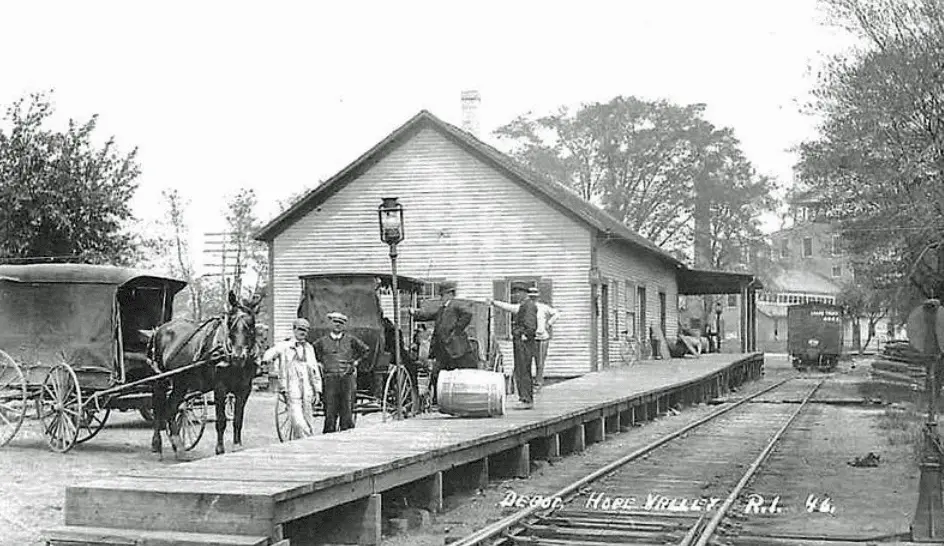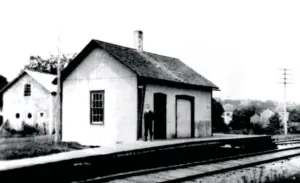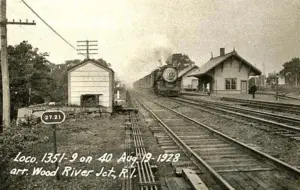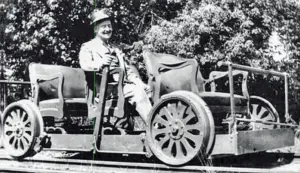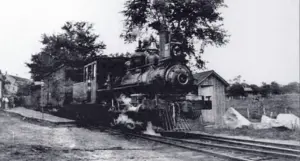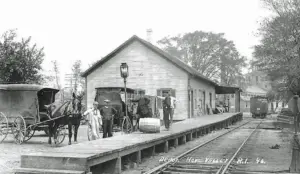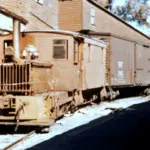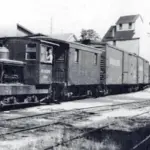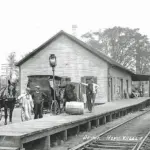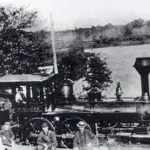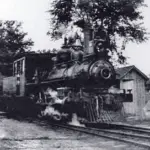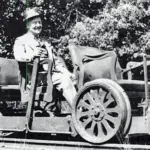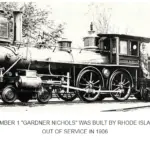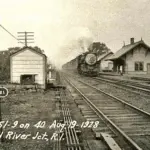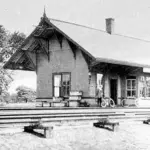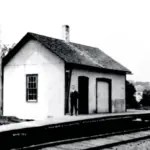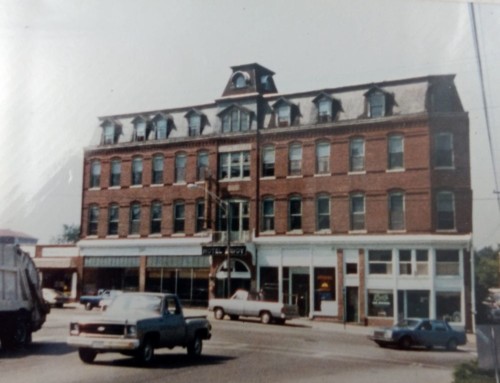The Wood River Branch Railroad was so small it only ran five and a half miles. The line had three depots: Canonchet, Woodville, and Hope Valley. All three were painted yellow which inspired the nickname “Yellow Dog Road.” In 1937, the tiny railroad was purchased for $301 by Roy Rawlings, certainly one of the best bargains in history.
The railroad first came to this area of Rhode Island in 1837. It was the Stonington-Providence Line and in 1872 its name changed when a number of smaller lines consolidated to form the New York, New Haven, and Hartford Railroad. That same year a branch of the railroad was extended closer to the mills at Woodville, Wyoming, Hope Valley, and Canonchet. Thus the Wood River Branch Railroad was born, making its first run on July 1, 1874.
The Wood River Branch Railroad was an immediate success. The mills were dependent on the line to get raw materials in and manufactured items out. Raw cotton was shipped in, woven at the mills, and finished cloth shipped out. Railroad ties were in high demand and stacks of finished ties were left by the depots, ready for loading. Local manufacturers would arrive in carriages and wagons with goods to be exported, there were baskets from the Niles Brothers shop and machinery from the Nichols and Langworthy Mill.
The first engine bought was a 20-ton brass-trimmed steam locomotive nicknamed Old Polly. The following year the Line acquired a passenger car and a baggage car and was carrying around 20,000 passengers annually. The fare was 25 cents.
Frank D. Bailey, of Westerly, wrote about his fond memories of the railroad for a local paper.
“As a small boy in Hope Valley I can remember riding this train and as the passenger car sat idle waiting for the trip to Wood River Junction engineer Tom Briggs backed Old Polly up to the connection on the passenger car and hit it with a terrible bang, which scared me and I screamed and cried so bad that Tom Briggs heard me. He came back to the passenger car to see what happened.”
Bailey continued, “The great flood that hit that area when I was a young lad ended the operation of Old Polly, and also started the decline of freight and passenger service in that area. Later, Roy Rawlings took over the operation of the line to serve his grainery business. It had a small gasoline engine operated by Reat Schofield and made the run from Hope Valley to Wood River Junction for freight only. Being young boys we would hide
in the woods along Old Switch Road and at the sound of the approaching slow-moving train we’d wait for Reat and his engine to pass then jump on the railroad cars and ride to Wood River Junction, jump off the train when it slowed down, then hide in the woods and wait for the return trip to Hope Valley.”
By 1937, the New York, New Haven, and Hartford Railroad was ready to fold the Wood River Branch Railroad Company which had been operating at a deficit for many years. Roy Rawlings, a former speaker of the Rhode Island House of Representatives, owned a large grain business in Hope Valley which was the line’s principal business. Rawlings knew his business would be ruined if the line was abandoned. He asked the New Haven Railroad people how much they wanted for the line and they came back with the answer, $301.00.
“That payment made me the principal owner and the president of a tiny railroad,” said Rawlings. “Our only
rolling stock consisted of a gasoline engine, leased from the New Haven Line and an old caboose. The branch used to have passengers, mail, freight, and express service. But all that’s gone. The line runs so deep in the red that I had all the equipment painted red just as a reminder.”
Martin Sheridan took a ride on the railroad in the late 1930s just before its demise and described the trip in Tidings Magazine.
“We pulled out at precisely 10:45 one morning and rolled along the wavy track at 12 miles an hour; three minutes later, Reat Schofield braked the train to a stop, ‘I’ll be back in a minute,’ he said. ‘Jimmy Allen’s danged cow is on the tracks again.’ On some days he had to shoo horses from the rail; on others, chickens and sheep and an occasional dog. We started up again and covered about three miles when the engineer pressed the brake lever again. ‘Come on down to the
brook and I’ll show you some of the fattest trout in the state,’ he smiled. We watched the fish for a while, picked some blueberries, and swung aboard the engine once more. Upon arriving at Wood River Junction, Schofield backed the train onto a siding, ran into the railroad office and came out with a handful of bills of lading. Then he coupled three cars onto his engine and off we went on the return trip, making the run in 23 minutes.”
During the railroad’s final days it struggled financially. A few of the towns that it had served exempted the Line from taxes, but it wasn’t enough. In 1947 a fire destroyed the Rawlings grain mill, the major reason for its existence. The family put the railroad up for sale but there were no takers. In February 1948, the Wood River Branch Railroad passed quietly into history.
- Gasoline engine 1938
- Hope Valley Station-1914
- Old Engine
- Ole Polly, steam engine
- Roy Rawlings riding his Presidential Special
- Steam Engine
- Wood River Junction 1928
- Wood River Junction Station
- Woodville
